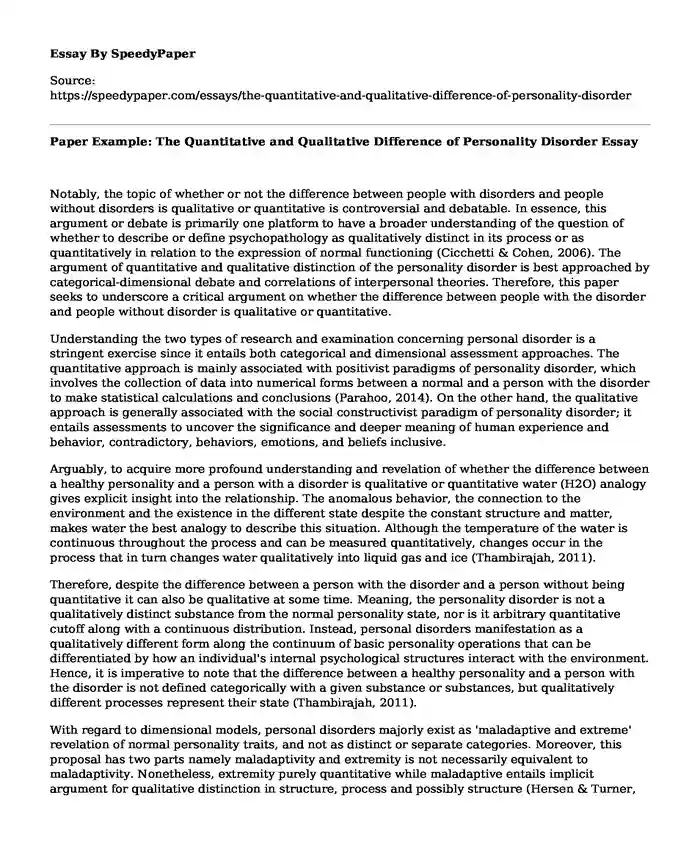
| Type of paper: | Creative writing |
| Categories: | Personality Mental health Personality disorder Psychological disorder |
| Pages: | 3 |
| Wordcount: | 694 words |
Notably, the topic of whether or not the difference between people with disorders and people without disorders is qualitative or quantitative is controversial and debatable. In essence, this argument or debate is primarily one platform to have a broader understanding of the question of whether to describe or define psychopathology as qualitatively distinct in its process or as quantitatively in relation to the expression of normal functioning (Cicchetti & Cohen, 2006). The argument of quantitative and qualitative distinction of the personality disorder is best approached by categorical-dimensional debate and correlations of interpersonal theories. Therefore, this paper seeks to underscore a critical argument on whether the difference between people with the disorder and people without disorder is qualitative or quantitative.
Understanding the two types of research and examination concerning personal disorder is a stringent exercise since it entails both categorical and dimensional assessment approaches. The quantitative approach is mainly associated with positivist paradigms of personality disorder, which involves the collection of data into numerical forms between a normal and a person with the disorder to make statistical calculations and conclusions (Parahoo, 2014). On the other hand, the qualitative approach is generally associated with the social constructivist paradigm of personality disorder; it entails assessments to uncover the significance and deeper meaning of human experience and behavior, contradictory, behaviors, emotions, and beliefs inclusive.
Arguably, to acquire more profound understanding and revelation of whether the difference between a healthy personality and a person with a disorder is qualitative or quantitative water (H2O) analogy gives explicit insight into the relationship. The anomalous behavior, the connection to the environment and the existence in the different state despite the constant structure and matter, makes water the best analogy to describe this situation. Although the temperature of the water is continuous throughout the process and can be measured quantitatively, changes occur in the process that in turn changes water qualitatively into liquid gas and ice (Thambirajah, 2011).
Therefore, despite the difference between a person with the disorder and a person without being quantitative it can also be qualitative at some time. Meaning, the personality disorder is not a qualitatively distinct substance from the normal personality state, nor is it arbitrary quantitative cutoff along with a continuous distribution. Instead, personal disorders manifestation as a qualitatively different form along the continuum of basic personality operations that can be differentiated by how an individual's internal psychological structures interact with the environment. Hence, it is imperative to note that the difference between a healthy personality and a person with the disorder is not defined categorically with a given substance or substances, but qualitatively different processes represent their state (Thambirajah, 2011).
With regard to dimensional models, personal disorders majorly exist as 'maladaptive and extreme' revelation of normal personality traits, and not as distinct or separate categories. Moreover, this proposal has two parts namely maladaptivity and extremity is not necessarily equivalent to maladaptivity. Nonetheless, extremity purely quantitative while maladaptive entails implicit argument for qualitative distinction in structure, process and possibly structure (Hersen & Turner, 2003). In as much as the difference between a normal and a person of the disorder is quantitative, as most Personal Disorders (PDs) cases, there will always be an element of qualitative distinction. Therefore, the discussion on 'categorical-dimensional debate' as to whether the difference between the personality and PDs is qualitative or quantitative is always endless since the two go simultaneously as analogized by the H2O analogy.
In conclusion, concerning the above discussion, the difference between normal personality and a person with a personality disorder is not defined categorically with merely a given substance or substances, but qualitatively different processes represent their state. Thus, the distinction between personality and Personal Disorders is both quantitative and qualitative since the extreme (quantitatively) manifestations of a personality disorder are always accompanied by qualitatively (maladaptive) differences in the process.
References
Cicchetti, D., & Cohen, D. J. (2006). Developmental Psychopathology. Hoboken, NJ: John Wiley & Sons.
Hersen, M., & Turner, S. M. (2003). Adult psychopathology and diagnosis. Hoboken, N.J: J. Wiley.
Parahoo, K. (2014). Nursing research: Principles, process, and issues. Houndmills, Basingstoke, Hampshire: Palgrave Macmillan.
Thambirajah, M. S. (2011). Developmental assessment of the school-aged child with developmental disabilities: A clinician's guide. London: Jessica Kingsley Publishers.
Cite this page
Paper Example: The Quantitative and Qualitative Difference of Personality Disorder. (2023, Mar 03). Retrieved from https://speedypaper.com/essays/the-quantitative-and-qualitative-difference-of-personality-disorder
Request Removal
If you are the original author of this essay and no longer wish to have it published on the SpeedyPaper website, please click below to request its removal:
- Research Paper Sample: Obesity Trends among Low-income Earners
- Free Essay on Mindfulness Cognitive Behavioral Therapy (CBT) for a Panic Event
- Essay Sample on the Topic: How Technology Affects Business
- Essay Sample of Creative Writing: Star Power Nationals
- China's Consumer Attitudes
- Free Essay Example. Health Care Debate
- Nourishing Insights: Case Studies on Diet, Digestion, and Skincare
Popular categories




